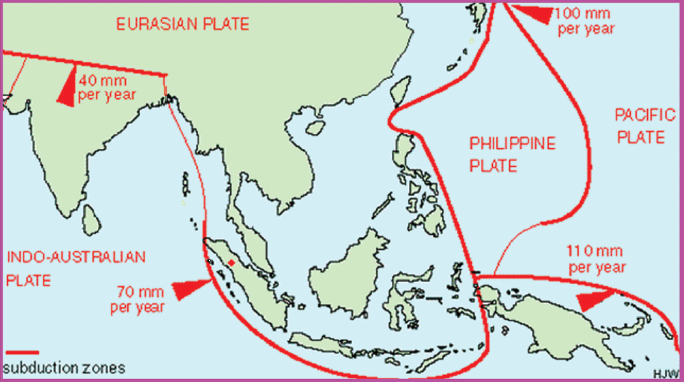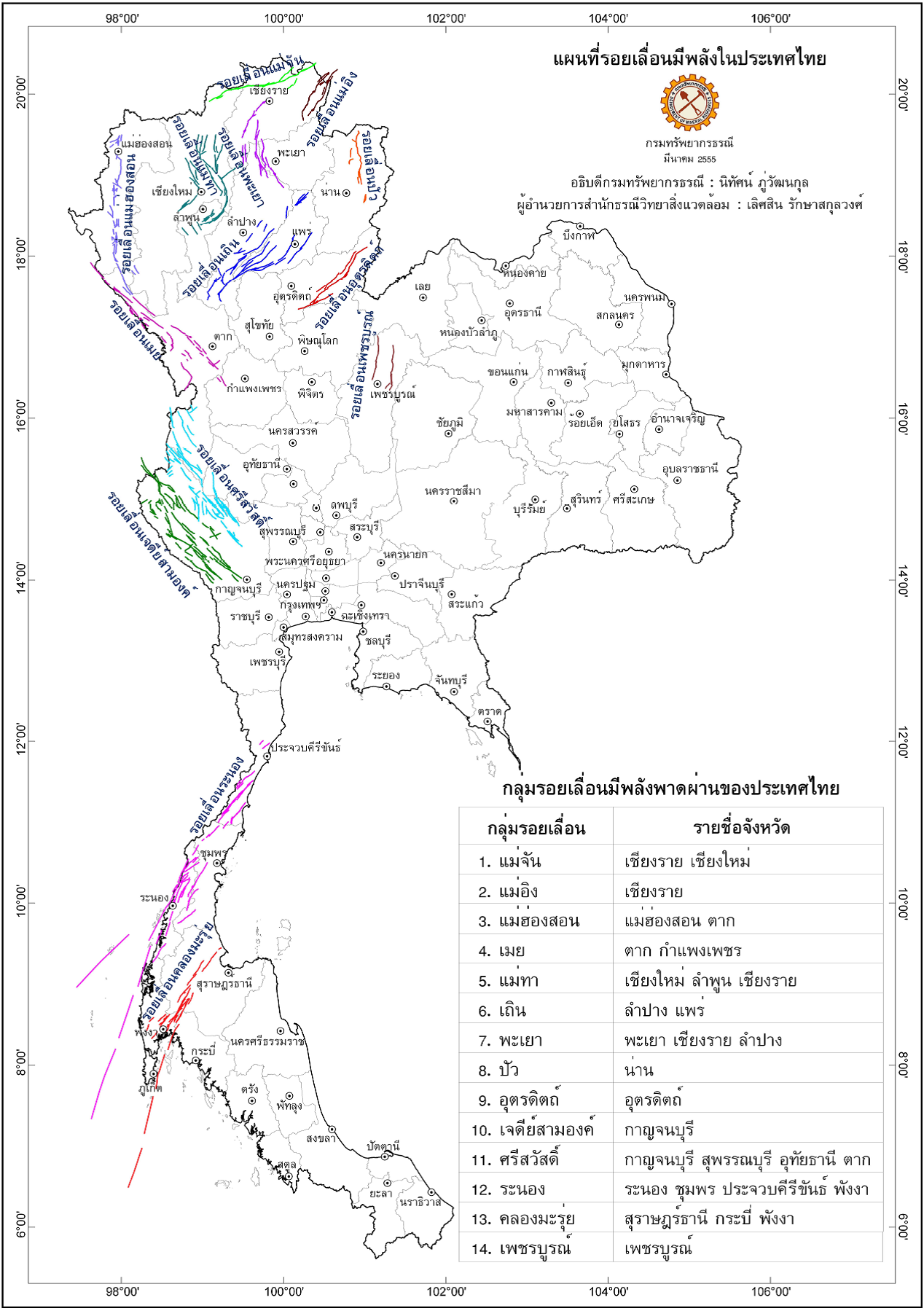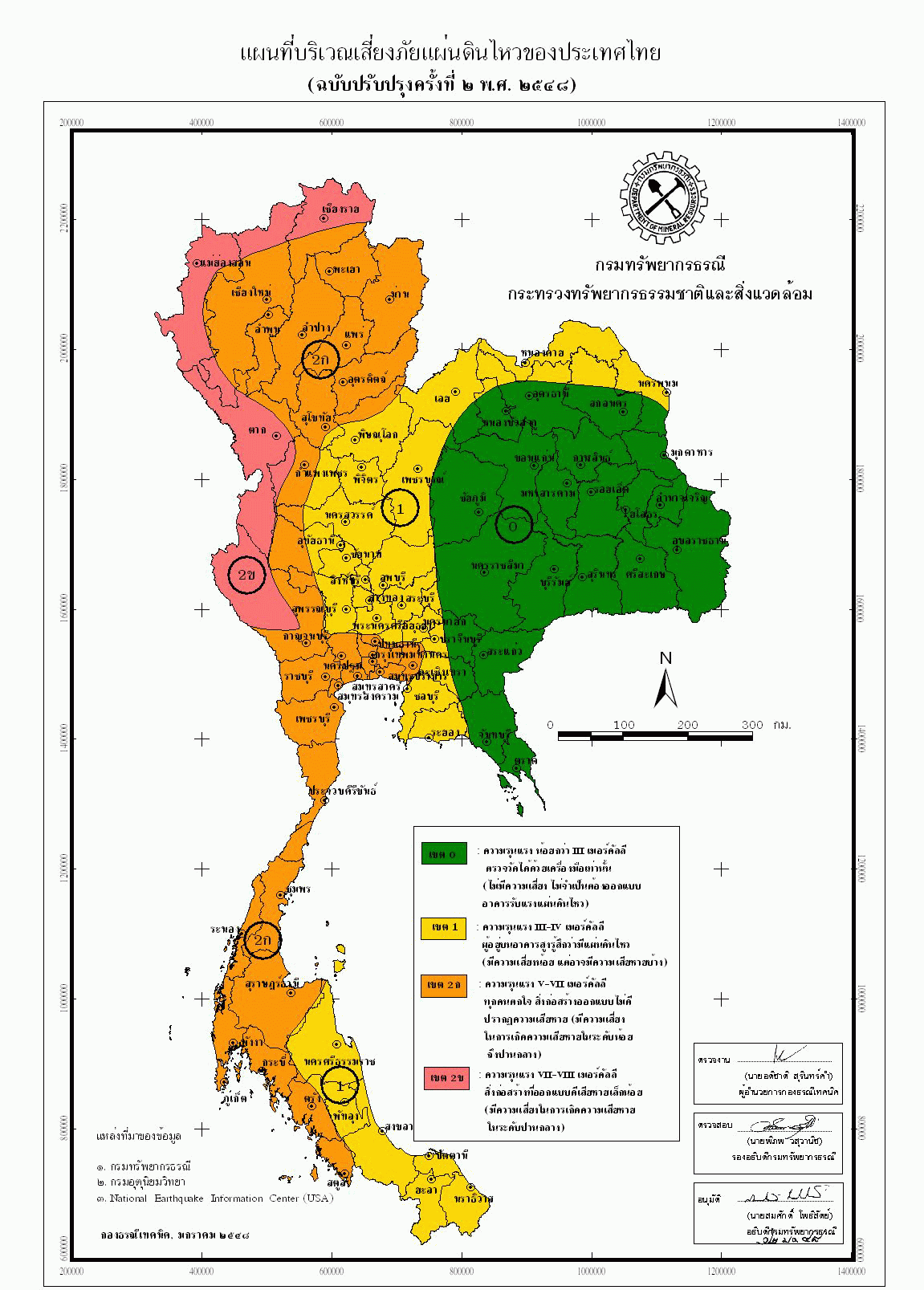Earthquakes in Thailand
Thailand sits on the Eurasian tectonic plate, which is flanked by the Indo-Australian and Pacific plates. While the country is located in a region that is relatively safe from earthquakes, but historical records show that the area has previously been affected by a number of tremors.
 The Indo-Australian plate is colliding into the Eurasian plate at a speed of 70 millimeters per year. |
Risk of earthquakes
A survey conducted by the Department of Mineral Resources revealed 14 groups of active faults spread across 22 provinces in Thailand as of March 2012.
  Source: Documents on ecological disasters, Department of Mineral Resources (http://www.dmr.go.th/ewt_news.php?nid=6814) |
Expert's opinion on the likelihood of earthquakes in Thailand
Assoc. Prof. Dr. Panya Jarusiri, Department of Geology, Faculty of Science, Chulalongkorn University
Source: ASTV Manager Daily newspaper, 1 May 2012
Daily News newspaper, 1 May 2012
"Assoc. Prof. Dr. Panya Jarusiri from the Department of Geology, Faculty of Science, Chulalongkorn University, confirmed to the ASTV Manager Online science desk that Phuket would not sink under the waves any time soon. The island sits on a base of solid stone that has lasted for more than 100 million years and is more than strong enough to withstand earthquakes. The series of rapid aftershocks is simply a natural post-earthquake phenomenon, and their shallow depths are the reason why people on the surface are feeling the tremors.
Previously, researchers in Thailand were most interested in the Mae Chan fault, which goes through the provinces of Chiang Rai and Chiang Mai. The fault is seen as the most potentially damaging one in the country in the event of an earthquake, and it may have been affected by major quakes in China's Yunnan province back in 2009 as well as last year's incident in Laos and Myanmar's Nam Ma fault. Today, Mae Chan fault remains quiet as stress continues to build up. Historical records show that the fault unleashed its power over 1,000 years ago, leading to the fall of the great city of Yonok.
However, the recent earthquake in Phuket has put the spotlight on the Ranong and Khlong Marui faults in southern Thailand, while Department of Mineral Resources officials are investigating the possible discovery of a new fault in the region. What worries Assoc. Prof. Dr. Panya the most is the buildup of stress at both faults, which may lead to a major earthquake.
Geological evidence indicates that earthquakes of magnitude 6 to 7 were triggered by the two faults 2,000 and 4,000 years ago, which means that we are approaching the return period for another major quake. According to Assoc. Prof. Dr. Panya, the fact that there has been no such quake means that the faults are still building up their energy, and we cannot predict when this energy will be released."
"Assoc. Prof. Dr. Panya Jarusiri from Chulalongkorn University's Department of Geology revealed that researchers are now focusing their work on active faults in southern Thailand following the recent minor earthquake in Phuket, which is not strong enough to cause the island to sink as rumored in some quarters.
Assoc. Prof. Dr. Panya said that the Mae Chan fault - a major fault in the northern province of Chiang Rai that is now building up stress - is no longer the only geological feature of interest in the country. Down south, the coastal Ranong fault is capable of triggering an earthquake of magnitude 5 to 6, although so far it has only caused small undersea tremors that did not have enough power to create a tsunami.
The Ranong fault is thus an area of concern as it continues to build up stress, noted Assoc. Prof. Dr. Panya. Geological evidence indicates that faults in southern Thailand like the Ranong and Khlong Malui faults have previously caused land earthquakes of magnitude 6-7 roughly 2,000 years ago. Another major quake at these faults may happen at any time and is an impossible event to predict.”
Prof. Dr. Panithan Lakkhunaprasith, head of the Center of Excellence in Earthquake Engineering and Vibration, Chulalongkorn University
Source: Daily News newspaper, 1 May 2012
"Prof. Dr. Panithan Lakkhunaprasith, chief of the Center of Excellence in Earthquake Engineering and Vibration, Chulalongkorn University, said that recent tremors in the Andaman Sea and Phuket had caused widespread panic and growing rumors among citizens in the area, prompting researchers to emerge with accurate geological information as a response. The earthquake felt on April 11 and the increased frequency of tremors in recent times were seen by many as consequences of the massive magnitude-9.1 quake in 2004. While this is unlikely to be the case as the faults in this region are more than 100 kilometers apart, further studies of the faults are still required. As for the possibility that the faults in Thailand will turn into dip-slip faults, he noted that this would be impossible as the footwalls of these faults only move laterally.
Prof. Dr. Panithan added that Phuket would definitely not sink into the sea after the recent earthquake, which originated from a small fault of indeterminate type. Most faults in the area around Phuket are either inactive or last active 10,000 years ago, and tremors here occur in solid layers of stone that are more than 100 million years. In order to sink the island, there must be a massive earthquake with a magnitude of 9 or more - a highly unlikely event. Additionally, Phuket does not sit on a dip-slip fault. While the island is currently sinking at a rate of 1 centimeter per year, this is a natural geological occurrence, and Phuket’s elevation level will shift and change over time.
Prof. Dr. Panithan believes that disaster preparation is vital. When accompanied by a number of other factors, earthquakes of magnitude 5.5 or more may be strong enough to severely damage buildings to the point of collapsing. So far, there have been very few such incidents in Thai history. Well-constructed buildings can easily withstand the force of a small tremor under magnitude 5 like the one in Phuket. The Department of Mineral Resources should quickly carry out a survey of active faults in each province in order to give the general public a clear view of the risk they face as well as a chance to prepare for possible earthquakes.
Assoc. Prof. Dr. Amorn Pimarnmart, Chairman of the Sub-Committee on Structural Engineering and Bridges, Engineering Institute of Thailand Under H.M. the King's Patronage
Source: IPRB newsletter, issue 24 (July - September 2011)
1. Are earthquakes growing more frequent all over the world?
Based on earthquake statistics from the past 10 years, there are more than 1,000 tremors per day around the world. Quakes of magnitudes 2-3 are usually not felt by people and have to be detected with the help of special equipment. Stronger earthquakes of magnitude 5 or more can cause damage to buildings if the area struck is well populated. On average, earthquakes of magnitudes 5.0-5.9 occur 1,500 times a year, 6.0-6.9 150 times a year, 7.0-7.9 15 times a year, and 8.0 or more once a year. The data we have today does not indicate that earthquakes are increasing in frequency.
2. How frequent do earthquakes happen in Thailand?
Thailand has a number of active faults with the potential to trigger tremors, many of which are concentrated in the northern and western regions. However, these faults do not have the capability to cause strong quakes like those in the Ring of Fire or in areas directly on top of tectonic plate boundaries. Over the past 40 years, Thailand has experienced mid-sized earthquakes (magnitudes 5.0-5.9) 8 times or once every 5 years. 5 of these tremors struck in the north, while the other 3 were centered in the west. Virtually all earthquakes recorded in Thailand are under magnitude 6.0, although significant seismic activity in far-away locations like Indonesia or Myanmar can be felt in areas with soft soil like Bangkok.
3. What factors affect the risk of danger from earthquakes?
The following factors can increase the threat of an earthquake:
1. Area struck by quake is close to a tectonic plate boundary, the Ring of Fire area, or an active fault.
2. Area sits on layers of soft soil.
3. Buildings in the area are not designed to cope with earthquakes. In case of non- earthquake-proof buildings standing on soft soil, there may be significant damage even if the earthquake is only of moderate magnitude.
4. Which areas in Thailand are prone to earthquakes?
The following parts of Thailand have higher risks of experiencing tremors:
1. Areas that may be affected by earthquakes: Krabi, Chumphon, Phang Nga, Phuket, Ranong, Songkhla and Surat Thani
2. Areas with soft soil, which may be affected by distant earthquakes: Bangkok, Nonthaburi, Pathum Thani, Samut Prakan and Samut Sakhon
3. Areas close to faults that may be affected by earthquakes: Kanchanaburi, Chiang Rai, Chiang Mai, Tak, Nan, Phayao, Phrae, Lampang, Lamphun and Mae Hong Son
5. What types of structures face high risk of damage in the event of an earthquake?
These structures are prone to damage from earthquakes:
1. Tenements with small columns supporting large beams; buildings no more than 4-5 stories high are particularly vulnerable
2. Buildings constructed out of flat slabs - e.g. parking structures and certain office buildings
3. Tall buildings with unorthodox designs, complex shapes and many decorative architectural elements
4. Buildings constructed using pre-fabricated components
5. Buildings that have been modified or expanded after initial completion, or buildings connected by walkways
6. Buildings that do not meet modern construction standards - e.g. structures built with non-reinforced brickwork
7. Buildings of all heights in the northern and western regions of Thailand, plus buildings taller than 5-6 stories and low-lying buildings with poor structural integrity in Bangkok
Buildings constructed after 2007 under Ministerial Regulation B.E. 2550 on Earthquake Resistant Design of Structures are safe from earthquake damage. Buildings constructed in years prior to the regulation, however, are likely to lack proper seismic design standards and thus require reinforcement of structural integrity to meet said standards.

